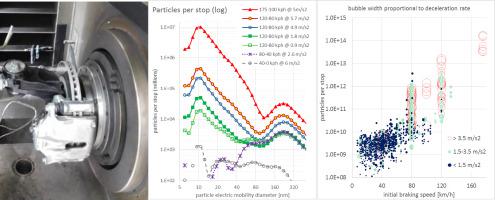Science of the Total Environment ( IF 8.2 ) Pub Date : 2021-05-15 , DOI: 10.1016/j.scitotenv.2021.147779 Michal Vojtíšek-Lom , Miroslav Vaculík , Martin Pechout , František Hopan , Alden Fred Arul Raj , Srinath Penumarti , Jiří Smokeman Horák , Olga Popovicheva , Jakub Ondráček , Barbora Doušová

|
Automobile friction brakes generate, in addition to coarse particles generated by mechanical processes, highly variable amount of nanoparticles from high temperature processes. The effects of braking conditions – speed, deceleration rate, brake rotor temperatures – on nanoparticle production were investigated here, aiming to provide practical guidance for reducing emissions through driving style and traffic management. Typical brake pads and a rotor from a common passenger car were subjected, on a brake dynamometer, to three runs of the WLTP brake cycle developed for brake wear particle measurements. Additionally, four sets of common brake pads were subjected to those parts of standardized brake performance tests believed to be reasonably realistic for common driving. Particle size distributions (5.6–560 nm electric mobility diameter, without removal of volatiles) show a dominant peak at 10 nm commensurate to the severity of braking and a non-linear increase of the total particle number at higher braking powers and higher total energy dissipated. The average emissions for three runs of the WLTP brake cycle were 3.3 × 1010 particles/km, while the harshest deceleration, 175–100 km/h at 5.28 m·s−2, has produced 8.4 to 38 × 1013 particles, corresponding to 2.5–11.5 thousands of km of WLTP-like driving. While previous studies have correlated higher PN production with higher average brake rotor temperature, a more complex relationship between nanoparticle emissions and a combination of initial rotor temperature, total energy dissipated and braking power has been observed here. From a driver behavior and regulatory perspective, it appears limiting harsh braking and braking from high speeds, possibly through improved driving practices, road design and traffic management, may potentially reduce brake wear nanoparticles. From the measurement perspective, it appears that “off-cycle” braking, even if relatively infrequent, may be associated with exponentially higher emissions and non-negligible share of the total emissions, and therefore should not be neglected.
中文翻译:

制动条件对乘用车摩擦制动器纳米颗粒排放的影响
除了由机械过程产生的粗颗粒之外,汽车摩擦制动器还产生来自高温过程的数量可变的纳米颗粒。本文研究了制动条件(速度,减速率,制动转子温度)对纳米颗粒生产的影响,旨在为通过驾驶方式和交通管理减少排放提供实用指导。在制动测功机上,对来自普通乘用车的典型制动片和转子进行了三个运行的WLTP制动循环运行,这些循环用于测量制动磨损颗粒。另外,对四组通用制动衬块进行了标准化制动性能测试的那些部分,这些测试被认为对于通用驾驶是相当现实的。粒径分布(5.6–560 nm电迁移直径,在没有去除挥发物的情况下)会在10 nm处出现一个与制动的强度相对应的主峰,并且在较高的制动功率和较高的总耗能下,总颗粒数呈非线性增加。WLTP制动循环的三个运行的平均排放量为3.3×1010个粒子/公里,而最剧烈的减速,即5.28 m·s -2时的175–100公里/小时,产生了8.4至38×10 13粒子,相当于2.5-11.5万公里的类似WLTP的行驶。尽管先前的研究已经将较高的PN产生与较高的平均制动转子温度相关联,但在此已观察到纳米颗粒排放与初始转子温度,总耗散能量和制动功率的组合之间更复杂的关系。从驾驶员行为和法规角度来看,似乎可以通过改进的驾驶习惯,道路设计和交通管理来限制苛刻的制动和高速制动,这可能会减少纳米级的制动磨损。从测量的角度来看,即使相对不频繁,“离线”制动似乎也可能与排放量成倍增加和排放总量中不可忽略的份额有关,因此不应忽略。











































 京公网安备 11010802027423号
京公网安备 11010802027423号